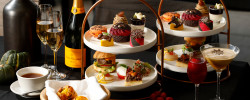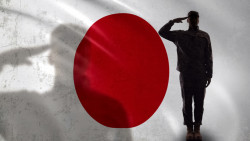
Originally published on metropolis.co.jp on January 2014

Outside Japan, partaking of teppanyaki meals (literally, “grilling on an iron plate”) can mean a gaudy show. A chef juggles his pepper grinder, offers up wisecracks and tosses food into the air. Diners are grouped with strangers around the cook at a U-shaped grill and the nature of dining with those you don’t know often makes for an awkward evening. If that has been your experience, then you may be hesitant to give it a try in Japan. Don’t be. Here teppanyaki is a respected culinary style. Most times you’ll have your own private chef, and the energy is focused on drawing out the flavors from the ingredients with a menu that changes seasonally rather than on a BeniHana two-step. At different ends of the spectrum, Keyakizaka at the Grand Hyatt Tokyo and Ukai-tei in Ginza offer two different takes on teppanyaki in Tokyo.
Ginza Ukai-tei

A thick, red carpet welcomes diners into Ginza Ukai-tei’s grand entrance, guarded by two stately silverware soldiers. Guests are then transported back in time as they enter the exquisitely furnished welcome room. Glamorous and over the top (in a good way), the museum-like space hosts pieces by René Lalique and Emille Galle. Even if you don’t know these artists, you’ll be struck by their works’ timeless craftsmanship.
While luxuriating at Ukai-tei be sure to request a private room, at no extra charge. The intimate experience of dining VIP-style with just your friends and the chef is arguably the only way to celebrate a special occasion.
The menu at Ukai-tei is not strictly teppan grill, as it includes classic European cuisine with dishes like smoked salmon and consommé. The steamed abalone is a signature dish, steamed under a mountain of salt until tender.
The tender Ukai wagyu is richly marbled with fat, cut into bite-size cubes and served with thin-sliced garlic the chef skillfully cooks into chips and freshly cracked black pepper. It pairs perfectly with the garlic rice. The wine list leans toward the French, which is actually perfect for the cuisine—and these classical European dishes work surprisingly well with teppanyaki.
On weekdays, lunch guests are escorted to a lounge where a dessert wagon is rolled up with pastries including classic sweets like macaroons, sables, caramels, marshmallows and petit fours. This is the ideal time to order a glass of brandy, cancel any afternoon plans and reflect on the state of teppanyaki today—far from the knife clatter and salt-n-pepper shaker percussion of western imitations.

Menu in Japanese & English

Lunch from ¥6,830, dinner from ¥16,800

All nonsmoking

Request a private room for the VIP treatment

Luxurious environment

May be expensive for some

Jitsushin Bldg. 5-15-8 Ginza, Chuo-ku

Lunch: Mon-Fri noon-2pm, Sat-Sun & hols 11:30am-3pm. Dinner: 5-9pm

www.ukai.co.jp/english/ginza/index.html
Keyakizaka


The first thing to capture your attention in this Michelin-starred restaurant on the fourth floor of Roppongi Hills is the wide selection of vegetables behind the long, iron grill. This time of year, various root vegetables, mushrooms and kabocha (squash) are some of what you’ll see. Their names are spelled out in Japanese, but ask your chef and he can tell you they are in English.
The course starts with foie gras, seared on the teppan grill and served with caramelized figs and a sweet balsamico sauce. The kinmedai (alfonsino) and seasonal vegetables are tied up in what appears to be plastic wrap, heated directly on the grill—a dramatic presentation. When the bag is opened after cooking, the fish has infused the vegetables with an ocean aroma that wafts over the table.
The kuroge wagyu (Japanese Black beef), while streaked with fat, is still a very succulent cut. Grilled with eggplant and bell pepper, the steak is cut into slices and served with two sauces, goma (sesame) and tomato. The dish that follows is uni (sea urchin) grilled with rice and decorated with nori and a fried quail’s egg. The uni lost some of its supple texture when cooked, but was still extravagant.
Watching the chef create each dish contributes as much to the sensory experience as the simple but mouthwatering tastes—one of the true pleasures of teppanyaki. Before grilling each serving, he presents the ingredients, like a sommelier the first sip of wine, and only then does preparation begin.
Keyakizaka offers a selection of mostly New World wines, with many biodynamic or organic selections. From the short list of nihonshu, we chose the rich Kuro Obi Yamahai Junmaishu (¥2,100) to complement the lunch.
Our meal ends with the chef caramelizing a strawberry, blueberry, and raspberry clafoutis (a crustless, flan-like tart) with a cooking torch. We were then escorted to a lounge area to finish with dessert and a coffee.
It’s a creative and international take on teppanyaki with flavors absorbed into this traditional Japanese cuisine from all over the world. The restaurant is a bit hard to find so allow some time to get lost—your efforts will be rewarded.

Menu in Japanese & English

Lunch from ¥4,000, dinner from ¥17,000

All nonsmoking except private rooms

Private rooms for up to six, but big counter is more dramatic

Unique use of sauces

Can be difficult to find

6-10-3 Roppongi, Minato-ku

Lunch 11:30am-2:30pm, dinner 6-9:30pm








